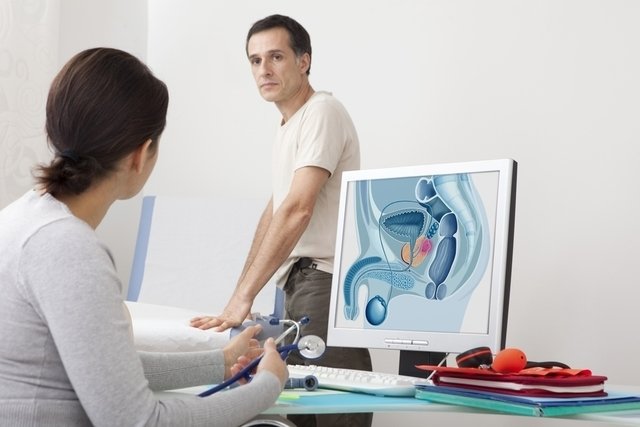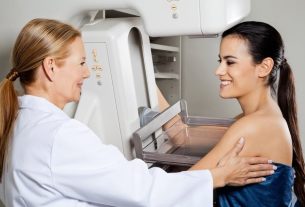Prostate cancer is the malignant tumor of the prostate, being the second most common type of cancer in men, especially after age 50. Initially, prostate cancer does not cause symptoms, however, as the tumor grows, symptoms may arise, such as difficulty urinating, constant sensation of full bladder and pain when urinating, for example.
As prostate cancer develops slowly, it is important that men regularly consult the urologist, especially from the age of 50, or 45 years in case of having a history of prostate cancer in the family, so that tests are done that evaluate prostate health and cancer risk.
Symptoms of prostate cancer
The main symptoms of prostate cancer are:
- Frequent desire to urinate;
- Difficulty initiating urination and weak urine jet;
- pain when urinating or ejaculating;
- Difficulty in maintaining the erection;
- Blood in urine or semen;
- Feeling of incomplete emptying of the bladder;
- Pain in the testicle area.
These symptoms arise as the tumor grows, as at an early stage it usually does not cause symptoms.
If the cancer has spread to other organs, other symptoms may appear, such as bone pain, leg swelling, pain in the abdomen, cough, excessive tiredness, weight loss for no apparent reason or general malad to be, for example.
In the presence of symptoms of prostate cancer, it is important to consult the urologist so that an evaluation is made and tests are indicated that help identify the cause of the symptoms. Check out other symptoms of prostate cancer.
You have symptoms of prostate cancer, make an appointment with a urologist in the nearest region:
Taking care of your health has never been easier!
Make an appointment with our Urologists and receive the personalized care you deserve.
Online test of symptoms
To find out if there is a risk of having problems in the prostate, indicate below the symptoms that you present:
The test of symptoms is only a guidance tool, not serving as a diagnosis nor replaces the consultation with the urologist.
How the diagnosis is made
The diagnosis of prostate cancer is made by the urologist through the evaluation of symptoms, health history and family history of prostate cancer.
In addition, the doctor should request the free and total PSA dosage in the blood, PCA3 test in the urine and do the rectal examination, in which the doctor can feel the prostate and evaluate the presence of a hard and firm nodule, which is indicative of cancer.
If changes are identified in these tests, the doctor may indicate the ultrasound-guided prostate biopsy to confirm the diagnosis. Know the tests that evaluate the prostate.
When prostate cancer is confirmed, the urologist should refer the patient to see with the oncologist, who may indicate additional tests to evaluate the stage of the cancer and start treatment.
Possible causes
Prostate cancer is caused by mutations in the DNA of prostate cells that begin to multiply abnormally and uncontrolled.
Some factors may increase the risk of prostate cancer, such as:
- Have a first-degree relative (parent or sibling) with a history of prostate cancer
- Be over 50 years of age;
- Doing a diet that is not balanced and very high in fats or calcium;
- Suffering from obesity or overweight;
- Elevated levels of testosterone persistently.
In addition, men of African-American people are also twice as likely to have prostate cancer, than any other ethnicity.
How the treatment is done
Treatment for prostate cancer should be guided by the oncologist, and may vary according to the age of the man, severity of the disease and if there are other associated diseases. It can be recommended:
1. Medical follow-up
Regular medical follow-up may be indicated for low-grade prostate cancer, which grows very slowly, especially in the elderly who do not have symptoms or men who have other diseases and whose life expectancy is 10 years or less.
Thus, it is necessary to make medical consultations with the urologist and/or oncologist on a regular basis and blood tests, rectal touch and biopsy to monitor the evolution of the tumor.
2. Surgery
Surgery for complete removal of the prostate, called radical prostatectomy, is one of the treatments that can be indicated for prostate cancer confined in the prostate, in order to cure cancer and prevent it from spreading to other organs forming metastases in the lymph nodes, bones, liver, lungs, bladder or intestines, for example.
Complete removal of the prostate may also be indicated for advanced prostate cancer in association with other treatments. Learn more about prostate cancer surgery and recovery.
3. Radiotherapy
Radiotherapy is done with the objective of eliminating or reducing the growth of cancer cells, being indicated to complement the surgical treatment of prostate removal.
However, it may also be indicated to replace surgery in cases where the tumor is confined to the prostate, in which case the choice of treatment should be made together with the oncologist, according to the risks and benefits of surgery and radiation therapy.
Radiation therapy can be applied by external radiation, through a machine that emits beams of radiation over the region of the prostate, but can also be done by brachytherapy, where the radioactive material is placed in or near the cancer.
The type of radiation therapy should be indicated by the doctor and depends on the stage of the tumor. In advanced cases, both external and internal radiation therapy can be used to relieve symptoms and improve quality of life.
4 Ablative therapy
Ablative therapy is done to destroy the tissues of the prostate using a cold gas directly in the prostate to freeze the tissues, which is called cryotherapy or cryoablation.
Another type of ablative therapy is the application of heat to the prostate through a focused high-intensity ultrasound, which heats the tissues of the prostate, causing its death.
Usually, this type of treatment for small prostate cancer, when it is not possible to have surgery to remove the prostate or in cases where there was no good response with radiation therapy.
5. Hormone therapy
Hormone therapy is a treatment for prostate cancer to prevent tumor growth and can be done with remedies to block testosterone production by the body or prevent testosterone from binding on tumor cells such as leuprolide, fat, fatarin, abiraterona, degarelix, flutamide, bicalutamide or enzalutamide, for example.
Another type of hormone therapy that can be indicated by the doctor is orchiectomy or surgical castration, which consists of a surgery for removal of the testicles, as they are responsible for the production of testosterone in the body.
6. Chemotherapy
Chemotherapy uses drugs directly in the vein, such as docetaxel, mitoxantron, estramustine, cisplatin or carboplatin, for example, which help to destroy the cancer cells located in the prostate or scattered throughout the body.
This type of treatment is indicated for the most advanced prostate cancer and can be done in combination with hormone therapy, according to the indication of the oncologist.
Does prostate cancer have a cure?
It is possible to achieve prostate cancer cure when it is identified in the initial phase and is located only in the prostate. In these cases, surgery is indicated to remove the prostate and completely eliminate the cancer.
However, depending on the age of the man and the stage of the disease, the oncologist can indicate other types of treatment, such as the use of remedies and even chemotherapy and radiation therapy to ensure that all cancer cells have been eliminated.
Common Doubts
The following are clear of the main doubts about prostate cancer:
1. Does prostate cancer only happen in the elderly?
Although more frequent in the elderly, prostate cancer can happen in any man, regardless of age, especially if they have a history of cancer in the family. Thus, it is important to always be aware of the appearance of signs or symptoms that may indicate problems in the prostate, consulting a urologist whenever this happens.
In addition, it is very important to do the annual screening, which is recommended from the age of 50 for apparently healthy men with no history of prostate cancer in the family, or from the 45 for men of the black race and those who have close relatives, such as father or brother, with history of prostate cancer.
2. Does having high PSA mean cancer?
The increased PSA value, above 4 ng/ml, does not always mean that there is cancer developing. This is because any inflammation in the prostate can cause an increase in the production of this enzyme, including problems much simpler than cancer, such as prostatitis or benign hypertrophy, for example. In these cases, although treatment is necessary, it is very different from the treatment of cancer, and the correct guidance of a urologist is necessary. Here’s how to understand the result of the PSA exam.
3. Is rectal examination really necessary?
The rectal examination can seem quite uncomfortable, so many men prefer to opt to perform only the PSA test as a form of cancer screening. However, rectal touch is very fast, painless and provides important information about the prostate.
There are also cases of recorded cancer in which it was not possible to observe any change in PSA levels in the blood, remaining equal to those of a man completely healthy and without cancer. Thus, rectal touch is an examination that can help the doctor identify any changes in the prostate, even if the PSA values are correct.
The ideal is to talk with the urologist about the indication of taking both tests together to try to identify the cancer.
Understand how the rectal touch exam is done.
4. Is having an enlarged prostate the same as cancer?
The enlargement of the prostate may, in fact, be a sign of cancer developing in the gland, however, the enlargement of the prostate gland can also arise in other problems, such as benign prostatic hyperplasia.
Benign prostatic hyperplasia, also known as prostatic hypertrophy, is also very common in men over 50 years, but it is a benign condition that may not even cause any symptoms or change in day-to-day life. Still, several men who have prostatic hypertrophy may also have cancer-like symptoms, such as difficulty urinating or the constant sensation of full bladder. Learn more about benign prostatic hyperplasia.
In these situations, it is always best to consult the urologist to correctly identify the cause of the enlarged prostate, initiating the appropriate treatment.
5. Do pumpkin seed reduce the risk of cancer?
Although pumpkin seeds are very rich in carotenoids, which are substances with potent antioxidant action capable of preventing various types of cancer, there is still no robust scientific evidence to recommend their use for the prevention of prostate cancer. In addition to pumpkin seeds, tomatoes have also been studied as an important food for the prevention of prostate cancer, due to its rich composition in lycopene, a type of carotenoid.
See more about what to eat to prevent prostate cancer.
6. Does cancer treatment always cause impotence?
Treatment of any type of cancer can be accompanied by various side effects, which may vary depending on the treatment modality.
In the case of prostate cancer, the main type of treatment used is surgery that, although considered safe, can also be accompanied by complications, including problems of erection and urinary incontinence.
However, this is more frequent in more advanced cases of cancer, when surgery is greater and it is necessary to remove a very enlarged prostate, which increases the risk of being affected important nerves related to the maintenance of erection. Understand more about the surgery, its complications and recovery.
7. Can Vasectomy Increase the Risk of Prostate Cancer?
Some studies have shown that vasectomy can slightly increase the risk of prostate cancer, while other studies have shown that there is no relationship between vasectomy and the increased risk of prostate cancer.
In this way, more studies are still needed to show whether or not there is a risk of developing prostate cancer in vasectomized men.

Sign up for our newsletter and stay up to date with exclusive news
that can transform your routine!
Warning: Undefined array key "title" in /home/storelat/public_html/wp-content/plugins/link-whisper-premium/templates/frontend/related-posts.php on line 12
Warning: Undefined array key "title_tag" in /home/storelat/public_html/wp-content/plugins/link-whisper-premium/templates/frontend/related-posts.php on line 13




